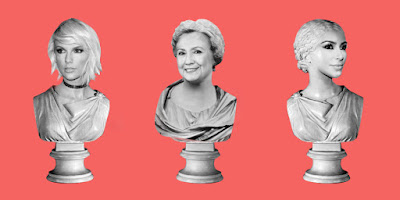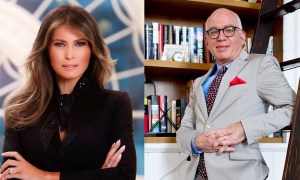This is a very interesting essay written by Caroline Burke for Marie
Claire, which talks about feminism and the different ways it can be
looked at. Using three types of women, Kim Kardashian, Taylor Swift, and
Hillary Clinton. Even though these women are all different and are in
different fields in life, they are collectively some of the most
multi-dimensional, talented, and successful women in recent history.
They’ve created empires for themselves, broken records, and shattered
ceilings. They’re quite literally pioneers for our gender, and yet we
still push them off into separate corners, swatting them back when they
try to flex their muscles
“It’s hard to talk about feminism today without mentioning some of the
most visible women in American culture: Kim Kardashian, Taylor Swift,
and Hillary Clinton. who have come to represent three distinct “kinds”
of accepted female identities sex and power; friendship and positivity;
ambition and success. Why should we, modern women, have to fit into just
one of these molds?
“It’s become impossible to talk about feminism without at least
mentioning the three most visible women in American culture today: Kim
Kardashian, who embodies sex and power, a new form of independence that
courts controversy for seeming, to some, degrading. Taylor Swift, who
embodies friendship and equanimity, the push to help other women and to
be relentlessly positive above all else. And Hillary Clinton, who
embodies ambition and career success and is judged for the exact lack of
the others’ traits: not being womanly enough, not being warm enough,
not being “enough” enough.
Through all the praise and criticism of social and mainstream media,
these women have come to represent the three distinct pillars of the
feminist agenda—no overlap, no wiggle room, no gray area. You’re either a
Taylor or a Kim or a Hillary—you can’t be all three, and they certainly
can’t either. (Or perhaps you’re a Beyoncé, who arguably produces
feminist art but whose personal politics we know next to nothing about).
“Maybe feminism is still too new and too threatening to be portrayed as
anything but cartoonishly simple, painted with broad strokes in black
and white.
And how lame is that? That these archetypes—which Swift, Kardashian, and
Clinton have been unwittingly cast in by our culture—leave no room for
complexity or humanness? That we still have to fit a mold, even while
breaking another one?
Taylor Swift has built an empire on being unapologetically girl-geared,
which explains why she, more than her pop-star peers, has been elevated
to the rank of feminist figurehead. Thanks to her squad and the
anti-bullying messages in her music, she’s been pigeonholed into a
“virginal” role, one that has nothing to do with actual sex and
everything to do with how she comes across: coy smiles, sweet makeup,
sleepovers with her friends. She can get away with a lot, but, as she
has noted, not with being seen with two men in the same week.
She’s expected to be Female Empowerment: Squeaky-Clean Edition.
If Swift represents girl gangs and that lean-in group mentality of
pushing other women forward with your own success, then Kardashian is
about empowerment of the self over all else.
Her brand of feminism is defined by a refusal to acknowledge or bend to
the opinions of others: Kardashian posts nude selfies. Kardashian
appropriates black culture. Kardashian oozes sex, demanding that you see
her for her body just as much as her motherhood, if not more. She
doesn’t smile—she pouts, smolders, and poses. She walks with her
impeccably dressed children in tow, looking you in the eye and daring
you to challenge the validity of her unabashed love of her own body.
Even her kids have a stare-down that would turn you to dust.
Then there’s Hillary Clinton, who may not be the Original Feminist, but
who, for a new generation, could be. She has stood proudly in those
pantsuits for decades with a firm, calm demeanor that seems to say,
“This is feminism, and it is work.”
Clinton’s feminism is tireless, in both appearance and effort. It isn’t
about fun or sex or self-empowerment so much as it is about the
unyielding work of being a woman. Clinton’s feminism isn’t pretty. It
doesn’t cater to sexuality or safety in numbers. It is in many ways the
most accurate indicator of what feminism feels like for many of us: a
job.
Of course, none of these figures is as one-dimensional as their
designated “characters” imply. But we’ve begun to compartmentalize
feminism into separate categories rather than allow it—and the people
inside it—breathing room.
Want proof? See what happens every time one of these women reveals
themselves to be multi-dimensional: We attack.
When Kardashian had a baby, the world lost its mind over the provocative
nude magazine cover that followed. Mothers can’t be sex objects!
When Swift was shown (by none other than Kardashian) to be a smart,
shrewd businesswoman concerned about—gasp!—her image, the world threw a
#TaylorSwiftIsOverParty.
Watch literally any news network right now and see how Clinton’s gender
is relentlessly analyzed simply for existing. Her voice is too stern!
She doesn’t smile enough! Her demeanor is too masculine, but her body is
too feminine and fragile—look, she just coughed!
There are, of course, countless other women who are redefining and
challenging female roles in society today, women who are quite literally
in the business of feminism: Laverne Cox, Roxane Gay, Ellen Page,
Chimimanda Ngozi Adiche, and Malala Yousafzai all defy
compartmentalization. But we don’t give them a fraction of the attention
that we give to Taylor Swift being seen in public with a man, or to Kim
Kardashian taking a selfie with her clothes off.
Read the rest here

















